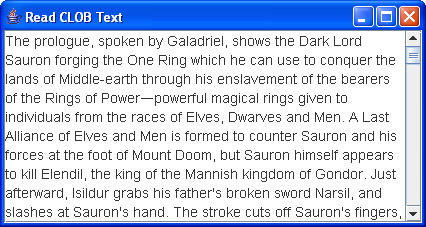Archive for the ‘clob’ tag
Reading a CLOB through the JDBC
I was working through some questions on the Oracle Technical forum, and thought it might be helpful to post a quick example for reading a CLOB from the database. It’ll produce the following Java Swing application view:
UTOUG web site updates links
There were two broken links in earlier blogs because UTOUG moved their presentation download repository. I’ve updated those links for my Utah Oracle User Group Training Days 2008 presentations. You can also uses these new links: PL/SQL 11g New Features and an Oracle LOBs. You can learn more about UTOUG and prior presentations at http://www.utoug.org, including Tom Kyte’s Materialized Views presentation from the same 2008 spring conference.
Oracle Database LOBs In-depth
Last month I presented the Oracle Database LOBs In-depth at the Utah Oracle User’s Group (UTOUG) Training Days. You can find the slides and sample programs here. The presentation illustrates how the transaction context works and how to access, maintain, and manage LOBs.
Cleaning up wasted LOB space
After replacing the contents of a BLOB or CLOB column, you will see the size grow because old indexes and segments aren’t deleted or removed from the index. The only way to get rid of the old information is to perform some simple table maintenance. The following provides an example of dumping redundant or obsolete space and indexes.
You should first check space, by using the query provided earlier in my blog to compare LOB indexes and segments. Such extremes as the regular expression in that query aren’t needed when DBAs ensure that LOBs are created with named segments. In this test case, this is the starting point:
TABLE COLUMN Segment Segment Name Name Segment Name TYPE Bytes ----- --------- ------------------------- ---------- --------- ITEM ITEM_BLOB SYS_IL0000074435C00007$$ LOBINDEX 65536 ITEM ITEM_BLOB SYS_LOB0000074435C00007$$ LOBSEGMENT 2097152 ITEM ITEM_DESC SYS_IL0000074435C00006$$ LOBINDEX 393216 ITEM ITEM_DESC SYS_LOB0000074435C00006$$ LOBSEGMENT 226492416 |
You create a temporary CLOB column in the target table. Then, you update the temporary column with the value from your real column.
ALTER TABLE item ADD (item_temp CLOB); UPDATE item SET item_temp = item_desc; |
When you requery the table’s indexes and segments, you’d find something like the following. You should note the size of the index and segments are three times larger in the real column than the temporary columns.
TABLE COLUMN Segment Segment Name Name Segment Name TYPE Bytes ----- --------- ------------------------- ---------- --------- ITEM ITEM_BLOB SYS_IL0000074435C00007$$ LOBINDEX 65536 ITEM ITEM_BLOB SYS_LOB0000074435C00007$$ LOBSEGMENT 2097152 ITEM ITEM_DESC SYS_IL0000074435C00006$$ LOBINDEX 393216 ITEM ITEM_DESC SYS_LOB0000074435C00006$$ LOBSEGMENT 226492416 ITEM ITEM_TEMP SYS_IL0000074435C00016$$ LOBINDEX 131072 ITEM ITEM_TEMP SYS_LOB0000074435C00016$$ LOBSEGMENT 65011712 |
You drop the real column and add it back, or simply rename the new table to the old column once you’ve dropped it. Then, you update the real column with the values from the temporary column.
ALTER TABLE item DROP COLUMN item_desc; ALTER TABLE item ADD (item_desc CLOB); UPDATE item SET item_desc = item_temp; |
You can now requery the table and find that you’ve eliminated extraneous space.
TABLE COLUMN Segment Segment Name Name Segment Name TYPE Bytes ----- --------- ------------------------- ---------- --------- ITEM ITEM_BLOB SYS_IL0000074435C00006$$ LOBINDEX 65536 ITEM ITEM_BLOB SYS_LOB0000074435C00006$$ LOBSEGMENT 2097152 ITEM ITEM_DESC SYS_IL0000074435C00016$$ LOBINDEX 131072 ITEM ITEM_DESC SYS_LOB0000074435C00016$$ LOBSEGMENT 65011712 ITEM ITEM_TEMP SYS_IL0000074435C00016$$ LOBINDEX 131072 ITEM ITEM_TEMP SYS_LOB0000074435C00016$$ LOBSEGMENT 65011712 |
You drop the temporary column after making the change.
ALTER TABLE item DROP COLUMN item_temp; |
You can now requery the table and find that you’ve eliminated extraneous space.
TABLE COLUMN Segment Segment Name Name Segment Name TYPE Bytes ----- --------- ------------------------- ---------- --------- ITEM ITEM_BLOB SYS_IL0000074435C00006$$ LOBINDEX 65536 ITEM ITEM_BLOB SYS_LOB0000074435C00006$$ LOBSEGMENT 2097152 ITEM ITEM_DESC SYS_IL0000074435C00016$$ LOBINDEX 131072 ITEM ITEM_DESC SYS_LOB0000074435C00016$$ LOBSEGMENT 65011712 |
Matching LOB Indexes and Segments
I enjoyed Tom Kyte’s example of how you find matching a LOB Index to Segment (Expert Oracle Database Architecture, pp. 542). I’ve noticed variations of it posted in various locations. While it works well for sample scheme that have only one LOB, the following works for any number of LOBs in any schema. This simplifies working with system- and user-defined segment names. The first CASE statement ensures that joins between user-named segment names are possible. The second CASE statement ensures two things: (a) Joins between system generated segment names don’t throw an error when matching unrelated system generated return values found in the DBA_SEGEMENTS view; and (b) Joins between named segments are possible and don’t throw an error.
COL owner FORMAT A5 HEADING "Owner" COL TABLE_NAME FORMAT A5 HEADING "Table|Name" COL column_name FORMAT A10 HEADING "Column|Name" COL segment_name FORMAT A26 HEADING "Segment Name" COL segment_type FORMAT A10 HEADING "Segment|Type" COL bytes HEADING "Segment|Bytes" SELECT l.owner , l.table_name , l.column_name , s.segment_name , s.segment_type , s.bytes FROM dba_lobs l , dba_segments s WHERE REGEXP_SUBSTR(l.segment_name,'([[:alnum:]]|[[:punct:]])+' , CASE WHEN REGEXP_INSTR(s.segment_name,'[[:digit:]]',1) > 0 THEN REGEXP_INSTR(s.segment_name,'[[:digit:]]',1) ELSE 1 END) = REGEXP_SUBSTR(s.segment_name,'([[:alnum:]]|[[:punct:]])+' , CASE WHEN REGEXP_INSTR(s.segment_name,'[[:digit:]]',1) > 0 THEN REGEXP_INSTR(s.segment_name,'[[:digit:]]',1) ELSE 1 END) AND l.table_name = UPPER('&table_name') AND l.owner = UPPER('&owner') ORDER BY l.column_name, s.segment_name; |
It produces the following type of output:
Table Column Segment Segment Name Name Segment Name Type Bytes ------ ---------- ------------------------- ---------- --------- PLSQL ITEM_BLOB SYS_IL0000074435C00007$$ LOBINDEX 65,536 PLSQL ITEM_BLOB SYS_LOB0000074435C00007$$ LOBSEGMENT 2,097,152 PLSQL ITEM_DESC SYS_IL0000074435C00006$$ LOBINDEX 65,536 PLSQL ITEM_DESC SYS_LOB0000074435C00006$$ LOBSEGMENT 720,896 |
This should help you monitor growth of LOBs in your database. The maximum CHUNK size is 32.768. If you elect a value greater than that you raise an ORA-22851 error.
